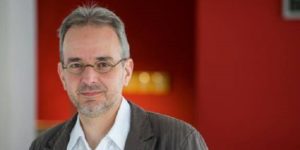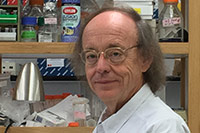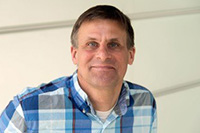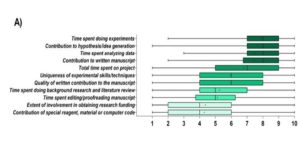Ralph Bock, Senior Editor
 Areas of expertise
Areas of expertise
Chloroplast biology; gene expression; photosynthesis; evolutionary genetics.
Ralph Bock is a Director at the Max Planck Institute of Molecular Plant Physiology and a Professor at the University of Potsdam. He received undergraduate and MSc degrees from the University of Halle, Germany and a PhD from the University of Freiburg. Dr. Bock uses a wide range of cutting-edge biochemical, physiological, and genetic techniques to investigate plant cell organelles, with interests ranging from organellar physiology and gene expression to metabolic and genetic interactions between organelles and other cellular compartments. In addition, his group is currently developing tools for plastid genome transformation for biotechnological applications such as metabolic engineering, molecular farming, and plant resistance engineering. He is also exploring genome evolution in eukaryotes and the genetic and evolutionary processes underlying the physiological plasticity of plant species and populations
Editorial experience
Advances in Photosynthesis and Respiration, Consulting Editor (2009-); Current Genetics, Editorial Board (2005-2014); Eukaryotic Cell, Editorial Board (2010-2012); Plant Biotechnology Journal, Editorial Board, (2013-); Plant Cell, Senior Editor (2015-); Transgenic Research, Associate Editor (2006-).
Honors and awards include
Elected Member of the German National Academy of Sciences (Leopoldina).


 James Birchler is Curators’ Professor at the University of Missouri, Columbia. He completed his BS degree at Eastern Illinois University and his PhD at Indiana University. Research interests of the Birchler laboratory include structure and behavior of chromosomes, centromere epigenetics, heterosis, polyploidy, and aneuploidy using maize as the model organism. Studies in Drosophila focus on gene silencing and dosage compensation. The Birchler lab constructed artificial/synthetic chromosome platforms in maize and is developing this technology further. Their general interests include the consequences of dosage-sensitive gene regulatory mechanisms in multicellular eukaryotes for the phenotype and evolutionary processes.
James Birchler is Curators’ Professor at the University of Missouri, Columbia. He completed his BS degree at Eastern Illinois University and his PhD at Indiana University. Research interests of the Birchler laboratory include structure and behavior of chromosomes, centromere epigenetics, heterosis, polyploidy, and aneuploidy using maize as the model organism. Studies in Drosophila focus on gene silencing and dosage compensation. The Birchler lab constructed artificial/synthetic chromosome platforms in maize and is developing this technology further. Their general interests include the consequences of dosage-sensitive gene regulatory mechanisms in multicellular eukaryotes for the phenotype and evolutionary processes. Sebastian Bednarek is a Professor in the Department of Biochemistry at the University of Wisconsin-Madison. He earned his PhD from Michigan State University. He is an expert on intracellular protein trafficking and membrane biogenesis and his work focuses on deciphering the molecular mechanisms underlying the formation of the cell plate, using both biochemical and genetic approaches.
Sebastian Bednarek is a Professor in the Department of Biochemistry at the University of Wisconsin-Madison. He earned his PhD from Michigan State University. He is an expert on intracellular protein trafficking and membrane biogenesis and his work focuses on deciphering the molecular mechanisms underlying the formation of the cell plate, using both biochemical and genetic approaches. Kassis asked biology, biomedical engineering and bioengineering faculty how important they considered several criteria for recognition as an author and rank on authorship list. A key finding is that, “Overall, there seemed to be a consensus that the time spent conducting experiments, coming up with a hypothesis, analyzing data, and writing the manuscript were the four most important criteria for both determining one’s authorship status and rank.” However, there was wide variation in the relative importance of several other criteria (including contributing a reagent or code, or conducting a literature review), indicating some inconsistency in how authorship decisions are made. The author suggests that these findings will help students navigate “the discrepancy between official policies for authorship and the contributions that faculty truly value.” [For more on authorship policies see
Kassis asked biology, biomedical engineering and bioengineering faculty how important they considered several criteria for recognition as an author and rank on authorship list. A key finding is that, “Overall, there seemed to be a consensus that the time spent conducting experiments, coming up with a hypothesis, analyzing data, and writing the manuscript were the four most important criteria for both determining one’s authorship status and rank.” However, there was wide variation in the relative importance of several other criteria (including contributing a reagent or code, or conducting a literature review), indicating some inconsistency in how authorship decisions are made. The author suggests that these findings will help students navigate “the discrepancy between official policies for authorship and the contributions that faculty truly value.” [For more on authorship policies see  Aircraft engines release CO2 into the atmosphere, but particles produced from aircraft emissions can also affect climate through aerosol production that leads to cloud formation. Moore et al. examined how incorporating plant-based biofuels (Camelina oil) affected the production of aerosols. They found that particle number and mass were reduced when biofuels were incorporated into the fuel, revealing another positive benefit of plant-derived biofuels to climate mitigation. Nature
Aircraft engines release CO2 into the atmosphere, but particles produced from aircraft emissions can also affect climate through aerosol production that leads to cloud formation. Moore et al. examined how incorporating plant-based biofuels (Camelina oil) affected the production of aerosols. They found that particle number and mass were reduced when biofuels were incorporated into the fuel, revealing another positive benefit of plant-derived biofuels to climate mitigation. Nature  Parasitic plants draw nutrients from their hosts. Spallek et al. explored the molecular interaction between the parasitic plant Phtheirospermum japonicum (in the Orobranchaceae family) and the model plant Arabidopsis thaliana. They demonstrated movement of tracers from the host to the parasite through the xylem. They also showed that cytokinin hormone synthesis is induced in the parasite upon attachment, and that these hormones move into the host and direct changes in morphology. Specifically, the parasite induced a swelling in the host tissue (hypertrophy) above the site of attachment, which included an increase in the area of the xylem. Mutant analysis showed that hypertrophy required host cytokinin response genes but not cytokinin synthesis genes, indicating that it is a response to parasite-synthesized and transported hormones. Proc. Natl. Acad. Sci. USA
Parasitic plants draw nutrients from their hosts. Spallek et al. explored the molecular interaction between the parasitic plant Phtheirospermum japonicum (in the Orobranchaceae family) and the model plant Arabidopsis thaliana. They demonstrated movement of tracers from the host to the parasite through the xylem. They also showed that cytokinin hormone synthesis is induced in the parasite upon attachment, and that these hormones move into the host and direct changes in morphology. Specifically, the parasite induced a swelling in the host tissue (hypertrophy) above the site of attachment, which included an increase in the area of the xylem. Mutant analysis showed that hypertrophy required host cytokinin response genes but not cytokinin synthesis genes, indicating that it is a response to parasite-synthesized and transported hormones. Proc. Natl. Acad. Sci. USA  Regulated movement to and from the plasma membrane (PM) has emerged as an important strategy for controlling the activity of plasma membrane proteins such as transporters and receptors. Jonsson et al. investigated the cellular machinery required for the insertion of the auxin-transport protein AUX1 into the plasma membrane from the trans-Golgi network. AUX1 is necessary for the ethylene-induced enhancement of the apical hook that protects the shoot as seedlings emerge from the soil. The authors address the contributions of ARFs and ARF-GEFs, proteins previously shown to be required for movement of vesicles from the trans-Golgi network. The authors found that different subtypes of ARF-GEFs (GNOMs and BIGs) act non-redundantly in apical hook formation. They also showed that BIGs and another protein, ECHIDNA (ECH) are both required for trafficking of AUX1 to the plasma membrane and maintenance of the apical hook. Plant Cell
Regulated movement to and from the plasma membrane (PM) has emerged as an important strategy for controlling the activity of plasma membrane proteins such as transporters and receptors. Jonsson et al. investigated the cellular machinery required for the insertion of the auxin-transport protein AUX1 into the plasma membrane from the trans-Golgi network. AUX1 is necessary for the ethylene-induced enhancement of the apical hook that protects the shoot as seedlings emerge from the soil. The authors address the contributions of ARFs and ARF-GEFs, proteins previously shown to be required for movement of vesicles from the trans-Golgi network. The authors found that different subtypes of ARF-GEFs (GNOMs and BIGs) act non-redundantly in apical hook formation. They also showed that BIGs and another protein, ECHIDNA (ECH) are both required for trafficking of AUX1 to the plasma membrane and maintenance of the apical hook. Plant Cell  How do stomata open in response to blue light? Blue light is perceived by phototropin receptor kinases that activate BLUE LIGHT SIGNALING1 (BLUS1), type 1 protein phosphatase (PP1), and the plasma membrane (PM) H+-ATPase. Hayashi et al. screened a commercial kinase inhibitor library to identify the kinases that phosphorylate PM H+-ATPase in response to blue light. Inhibitors that blocked blue light-stimulated phosphorylation of PM H+-ATPase share targets from members of the Raf-like kinase subfamily of MAPKKK enzymes. A mutant of a Raf-like kinase that is highly-expressed in guard cells could not open stomata in response to blue light. This gene was named BLUE LIGHT-DEPENDENT H+-ATPASE PHOSPHORYLATION (BHP), and its kinase activity is necessary for stomatal opening in response to blue light. BHP localizes to the guard cell cytoplasm. BHP binds to BLUS1 & PP1 in vitro, but not phototropins or PM H+-ATPase. Hayashi et al. identified BHP as a kinase that interacts with BLUS1 to indirectly regulate the PM H+-ATPase and stomatal movement. (Summary by
How do stomata open in response to blue light? Blue light is perceived by phototropin receptor kinases that activate BLUE LIGHT SIGNALING1 (BLUS1), type 1 protein phosphatase (PP1), and the plasma membrane (PM) H+-ATPase. Hayashi et al. screened a commercial kinase inhibitor library to identify the kinases that phosphorylate PM H+-ATPase in response to blue light. Inhibitors that blocked blue light-stimulated phosphorylation of PM H+-ATPase share targets from members of the Raf-like kinase subfamily of MAPKKK enzymes. A mutant of a Raf-like kinase that is highly-expressed in guard cells could not open stomata in response to blue light. This gene was named BLUE LIGHT-DEPENDENT H+-ATPASE PHOSPHORYLATION (BHP), and its kinase activity is necessary for stomatal opening in response to blue light. BHP localizes to the guard cell cytoplasm. BHP binds to BLUS1 & PP1 in vitro, but not phototropins or PM H+-ATPase. Hayashi et al. identified BHP as a kinase that interacts with BLUS1 to indirectly regulate the PM H+-ATPase and stomatal movement. (Summary by  Cell walls are complex mixtures of cellulose microfibrils, proteins and other materials. Their mechanical properties can be measured and modeled, but it is not always simple to translate these measurements to changes at the molecular level. Zhang et al. used atomic force microscopy to provide an unprecedented view of how cellulose microfibrils respond to stress and strain (if you are a bit fuzzy on the difference between stress and strain see Baskin’s excellent
Cell walls are complex mixtures of cellulose microfibrils, proteins and other materials. Their mechanical properties can be measured and modeled, but it is not always simple to translate these measurements to changes at the molecular level. Zhang et al. used atomic force microscopy to provide an unprecedented view of how cellulose microfibrils respond to stress and strain (if you are a bit fuzzy on the difference between stress and strain see Baskin’s excellent